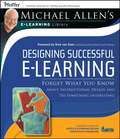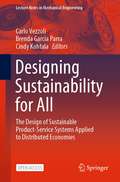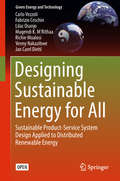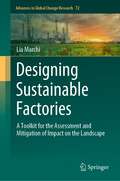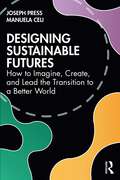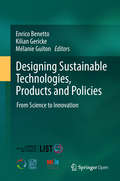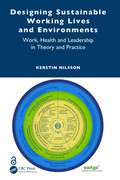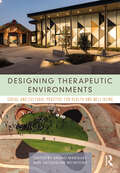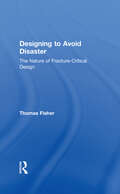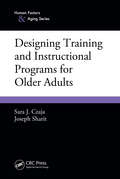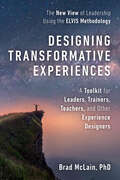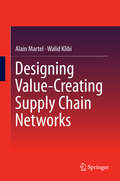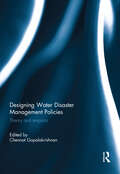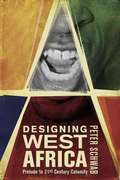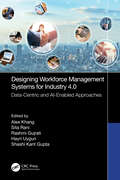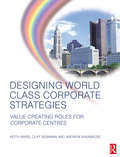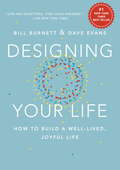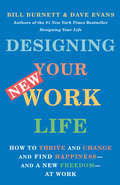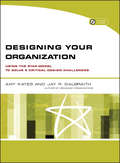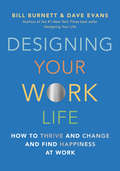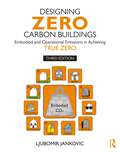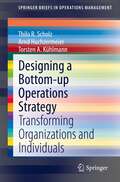- Table View
- List View
Designing Successful e-Learning
by Michael W. AllenThis is the second volume of six in Michael Allen's e-Learning Library--a comprehensive collection of proven techniques for creating e-learning applications that achieve targeted behavioral outcomes through meaningful, memorable, and motivational learning experiences. This book examines common instructional design practices with a critical eye and recommends substituting success rather than tradition as a guide. Drawing from theory, research, and experience in learning and behavioral change, the author provides a framework for addressing a broader range of learner needs and achieving superior performance outcomes.
Designing Sustainability for All: The Design of Sustainable Product-Service Systems Applied to Distributed Economies (Lecture Notes in Mechanical Engineering)
by Carlo Vezzoli Cindy Kohtala Brenda Garcia ParraThis open access book introduces design for Sustainable Product-Service Systems (S.PSS) and for Sustainable Distributed Economies (S.DE). These are introduced as technical and operative tools for the development of a new generation of designers, responsible and capable of designing environmentally, socially and economically sustainable solutions, accessible to all. The book provides a comprehensive framework and also practical tools to support the system design for sustainability process. It overviews methodologies, tools and strategies for Sustainable PSS design applied to Distributed Economies (DE) and provides strategies and design guidelines. All of these are highlighted and expanded upon with international case studies.
Designing Sustainable Energy for All: Sustainable Product-service System Design Applied To Distributed Renewable Energy (Green Energy and Technology)
by Jan Carel Diehl Fabrizio Ceschin Carlo Vezzoli Lilac Osanjo Mugendi K. M’Rithaa Richie Moalosi Venny NakazibweThis open access book addresses the issue of diffusing sustainable energy access inlow- and middle-income contexts.Access to energy is one of the greatest challenges for many people living in low-income and developing contexts, as around 1.4 billion people lack access to electricity.Distributed Renewable Energy systems (DRE) are considered a promising approachto address this challenge and provide energy access to all. However, even if promising,the implementation of DRE systems is not always straightforward.The book analyses, discusses and classifies the promising Sustainable Product-ServiceSystem (S.PSS) business models to deliver Distributed Renewable Energy systems in aneffective, efficient and sustainable way. Its message is supported with cases studies andexamples, discussing the economic, environmental and socioethical benefits as wellas its limitations and barriers to its implementation. An innovative design approach isproposed and a set of design tools are supplied, enabling readers to create and developSustainable Product-Service System (S.PSS) solutions to deliver Distributed RenewableEnergy systems.Practical applications of the book’s design approach and tools by companies andpractitioners are discussed and the book will be of interest to readers in design, industry,governmental institutions, NGOs as well as researchers.
Designing Sustainable Factories: A Toolkit for the Assessment and Mitigation of Impact on the Landscape (Advances in Global Change Research #72)
by Lia MarchiEconomic constraints and lack of knowledge often prevent companies - especially small and medium enterprises - from harmonizing their facilities with the landscape. As a result, factories significantly impact the quality of our living environment, in terms of physical effects on the ecosystem, perceptual interferences with the surroundings, and disturbances on local communities. At both the design and maintenance stages, a set of appropriate tools can assist businesses in becoming more aware of their impacts and identifying possible mitigation strategies. The book presents an assessment tool and a library of inspiring design tactics for factories, with examples of the benefits and synergies for the environment, the scenery, the community, and the company itself. The purpose is to elicit more than a simple reflection about what a sustainable factory entails. It is rather to encourage and assist both businesses and designers in mitigating the impact of industrial facilities on the landscape as holistically as possible.
Designing Sustainable Futures: How to Imagine, Create, and Lead the Transition to a Better World
by Manuela Celi Joseph PressWe are in a decisive decade that demands more inspired and informed practitioners who can use positive futures to rebalance the present. The book you hold seeks to be a thought‑provoking approach to imagine, create, and lead the journey to a more sustainable world – where a spectrum of choices, including regenerative practices, await conscientious citizens, companies, and communities.With this objective, and to help reverse the megatrends of economic disparity, social injustice, and climate change, the Institute for the Future (IFTF) and the Design Department of the Politecnico di Milano came together to prototype an approach to prepare all practitioners who seek to leverage the future to infuse our present with more impact and agency.Guided by global experts and inspired by a growing network of future‑makers, the authors share essential insights from this emerging landscape, offering thought‑provoking theory, innovative experiments, real‑world experiences, and practitioner stories. We draw insight and inspiration from many contemporary theories and practices, including strategic foresight, experiential futures, speculative design, design fiction, systems design, participatory design, and transformative leadership, and an emerging entry with genAI‑augmented design.Regardless of whether you have a design or management background, or want to create a for‑profit or non‑profit, this book enables professionals across industries, as well as students preparing for a career in strategy, innovation, or transformation, the knowledge, skills, and confidence to strengthen resilience and guide the transition to the more sustainable practices of a better world.
Designing Sustainable Technologies, Products and Policies: From Science To Innovation
by Enrico Benetto Kilian Gericke Mélanie GuitonThis open access book provides insight into the implementation of Life Cycle approaches along the entire business value chain, supporting environmental, social and economic sustainability related to the development of industrial technologies, products, services and policies; and the development and management of smart agricultural systems, smart mobility systems, urban infrastructures and energy for the built environment. The book is based on papers presented at the 8th International Life Cycle Management Conference that took place from September 3-6, 2017 in Luxembourg, and which was organized by the Luxembourg Institute of Science and Technology (LIST) and the University of Luxembourg in the framework of the LCM Conference Series.
Designing Sustainable Working Lives and Environments: Work, Health and Leadership in Theory and Practice
by Kerstin NilssonWork is central to people’s lives and the course of their life. The opportunities and chances an individual can have in their life are significantly connected to work. Individuals' work is also crucial for organisations, companies and for the whole of society. There is a constant need to make changes and readjustments of working life since these can deeply affect the individual and their employability. To make working lives more healthy, sustainable and attractive, being aware of the measures and changes that can be achieved in practice is of crucial importance. This book bridges the gap between the theories and explanatory models offered in research and actual work environments and workplaces.This book constitutes a theoretical framework that visualises the complexity of working life and increases the knowledge and awareness of individuals, companies, organisations and society regarding different factors and patterns. It aims to support individual reflections and joint discussions into daily operations on the individual, organisational and societal level. This book contains practical tools to use in daily working life that analyse possible risks in the work environment when planning measures and actions for health promotion. These practical tools are derived from the four spheres for action and employability in the SwAge model. Developed by the author, the SwAge model (Sustainable Working Life for All Ages) is a theoretical, explanatory model that explains the complexity of creating a healthy and sustainable working life for all ages. By using the SwAge model as a comprehensible framework, the reader will be able to visualise the complexity of factors that affect and influence whether people are able to and want to participate in working life and in the work environment, thereby contributing to increased employability.Designing Sustainable Working Lives and Environments is an essential read for students, researchers, work environment engineers, ergonomics and human factor specialists, occupational health and safety practitioners, business managers, HR staff, leadership decision-makers and labour union professionals.The Open Access version of this book, available at http://www.taylorfrancis.com, has been made available under a Creative Commons Creative Commons Attribution (CC-BY) 4.0 license
Designing Therapeutic Environments: Social and Cultural Practice for Health and Well-Being
by Bruno Marques Jacqueline McIntoshThis book draws on the relationship between culture and the environment and its connection with health and well-being. Therapeutic environments are settings that comprise the physical, ecological, psychological, spiritual and social environments associated with treatment and healing. Throughout the chapters, the understanding of therapeutic environments is broadened through the exploration of specific Indigenous cultural and social dimensions. Case studies comprise a combination of research papers regarding the theoretical and conceptual underpinnings of therapeutic environments and their application following traditional methods. This book contributes to the expanding body of knowledge focusing on the role of therapeutic environments and their role in shaping health and well-being through the development of new research methods.This book is essential for practitioners, scholars and students in architecture, landscape architecture, interior architecture, urban design, planning, geography, building science, public health and environmental engineering.
Designing To Avoid Disaster: The Nature of Fracture-Critical Design
by Thomas FisherRecent catastrophic events, such as the I-35W bridge collapse, New Orleans flooding, the BP oil spill, Port au Prince's destruction by earthquake, Fukushima nuclear plant's devastation by tsunami, the Wall Street investment bank failures, and the housing foreclosure epidemic and the collapse of housing prices, all stem from what author Thomas Fisher calls fracture-critical design. This is design in which structures and systems have so little redundancy and so much interconnectedness and misguided efficiency that they fail completely if any one part does not perform as intended. If we, as architects, planners, engineers, and citizens are to predict and prepare for the next disaster, we need to recognize this error in our thinking and to understand how design thinking provides us with a way to anticipate unintended failures and increase the resiliency of the world in which we live. In Designing to Avoid Disaster, the author discusses the context and cultural assumptions that have led to a number of disasters worldwide, describing the nature of fracture-critical design and why it has become so prevalent. He traces the impact of fracture-critical thinking on everything from our economy and politics to our educational and infrastructure systems to the communities, buildings, and products we inhabit and use everyday. And he shows how the natural environment and human population itself have both begun to move on a path toward a fracture-critical collapse that we need to do everything possible to avoid. We designed our way to such disasters and we can design our way out of them, with a number of possible solutions that Fisher provides.
Designing Training Programs
by Zeace Nadler Leonard NadlerFirst published in 1994. Routledge is an imprint of Taylor & Francis, an informa company.
Designing Training and Instructional Programs for Older Adults (Human Factors and Aging Series)
by Sara J. Czaja Joseph SharitCurrent and emerging trends in the domains of health management and the work sector, the abundance of new consumer products pervading the marketplace, and the desires of many older adults to undertake new learning experiences means that older adults, like their younger counterparts, will need to continually engage in new learning and training. Thus
Designing Transformational Customer Experiences
by Stefan ThomkeAnyone who has recently travelled, gone shopping, or tried to have a problem solved may have little recollection of the experience. Worse yet, some are frustrated by the lack of responsiveness or empathy that they encountered. The reality is that most customer experiences are mediocre, forgettable, and some are plain awful. But once in a blue moon, an experience is so great that it leaves positive memories for years. Why do some product or service experiences have that undeniable "wow" factor, while others lack that pizzazz, relegating them to either being loathed or erased from memory? This case prepares participants for an in-class exercise in which they discover design principles that make experiences great. The exercise uses two methodologies: LEGO® Serious Play® (LSP) and Storytelling. It requires the purchase of special purpose LEGO® elements. Teaching Note for HBS No. 617-051.
Designing Transformative Experiences: A Toolkit for Leaders, Trainers, Teachers, and other Experience Designers
by Brad McLainOffering a new lens on leadership and living, this research-based guide shows how to design experiences that can touch hearts, provoke minds, and change lives in powerful ways.Transformative experiences are life events that change our sense of self in important ways. How do they work? What elements do they require? How can we learn to design them intentionally?By embracing the research-based approach of ELVIS (the Experiential Learning Variables and Indicators System), this book details how to recast yourself as an Experience Design Leader, one that can provide those in your organization with the opportunities needed to reflect and grow as individuals.Beginning with the ELVIS Framework, you will gain deep foundational insight into how transformative experiences work. And then with the ELVIS Toolkit, which includes seven practical design elements, you will have the key to unlocking these powerful experiences for yourself and others.Whether you are new to the idea of designing experiences for others or are a seasoned veteran, ELVIS shows you how to tap into the psychology operating behind the most powerful and important experiences of our lives-those that shape who we are.
Designing Value-Creating Supply Chain Networks
by Alain Martel Walid KlibiFocusing on the design of robust value-creating supply chain networks (SCN) and key strategic issues related to the number; location, capacity and mission of supply chain facilities (plants, distribution centers) - as well as the network structure required to provide flexibility and resilience in an uncertain world - this book presents an innovative methodology for SCN reengineering that can be used to significantly improve the bottom line of supply chain dependent businesses. Providing readers with the tools needed to analyze and model value creation activities, Designing Value-Creating Supply Chain Networks examines the risks faced by modern supply chains, and shows how to develop plausible future scenarios to evaluate potential SCN designs. The design methods proposed are based on a visual representation formalism that facilitates the analysis and modeling of SCN design problems, book chapters incorporate several example problems and exercises which can be solved with Excel tools (Analysis tools and Solver) or with commercial statistical and optimization software.
Designing Water Disaster Management Policies: Theory and Empirics
by Chennat GopalakrishnanThis book represents a landmark effort to probe and analyze the theory and empirics of designing water disaster management policies. It consists of seven chapters that examine, in-depth and comprehensively, issues that are central to crafting effective policies for water disaster management. The author uses historical surveys, institutional analysis, econometric investigations, empirical case studies, and conceptual-theoretical discussions to clarify and illuminate the complex policy process.The specific topics studied in this book include a review and analysis of key policy areas and research priority areas associated with water disaster management, community participation in disaster risk reduction, the economics and politics of ‘Green’ flood control, probabilistic flood forecasting for flood risk management, polycentric governance and flood risk management, drought management with the aid of dynamic inter-generational preferences, and how social resilience can inform SA/SIA for adaptive planning for climate change in vulnerable areas.A unique feature of this book is its analysis of the causes and consequences of water disasters and efforts to address them successfully through policy-rich, cross-disciplinary and transnational papers. This book is designed to help enrich the sparse discourse on water disaster management policies and galvanize water professionals to craft creative solutions to tackle water disasters efficiently, equitably, and sustainably. This book should also be of considerable use to disaster management professionals, in general, and natural resource policy analysts.This book was published as a special issue of the Journal of Natural Resource Policy Research.
Designing West Africa: Prelude To 21st Century Calamity
by Peter SchwabMany African nations are now described as 'fourth world nations', ones which essentially have no future. How could this have happened? Through the scope of the 1960's, the first decade of African independence, Peter Schwab presents a compelling and provocative answer to this question. Designing West Africa tells the story of a pivotal decade in African history, when the fate of the continent was decided. Focusing on the six most visible leaders of the period - painting detailed portraits of them both as leaders and as people - Schwab looks at how Africa served as a ground to play out larger international conflicts, namely the Cold War. He does not fall back on blaming non-African involvement for the failure to build a visible leadership for the continent; rather he critiques the African leaders themselves for their individual failings.
Designing Workforce Management Systems for Industry 4.0: Data-Centric and AI-Enabled Approaches
by Alex Khang Sita Rani Rashmi Gujrati Hayri Uygun Shashi Kant GuptaThis book brings insight to the HR management system and offers data-centric approaches and AI-enabled applications for the design and implementation strategies used for workforce development and management. Designing Workforce Management Systems for Industry 4.0: Data-Centric and AI-Enabled Approaches focuses on the mechanisms of proposing solutions along with architectural concepts, design principles, smart solutions, and intelligent predictions with visualization simulation. Data visualization for the metrics of management systems and robotic process automation applications and tools are also offered. This book is also useful as a reference for those involved in AI-enabled applications, data analytics, data visualization, as well as systems engineering and systems designing.
Designing World Class Corporate Strategies
by Keith Ward Andrew Kakabadse Cliff BowmanDesigning World Class Corporate Strategies considers the key role of corporate centres within very large, primarily multi-business organisations. At present, these corporate centres are under attack as not creating and value and merely adding cost to their groups.The authors have developed a corporate configurations model which demonstrates four ways in which corporate centres can add significant value. However this requires the centre to act in specific ways depending on the external environment in which the group is operating.Designing World Class Corporate Strategies is highly readable, with a large number of illustrative examples included in the text. Academic references and theoretical underpinnings are placed in the final chapter of the book, so that the book is focused on the professional market for strategy and creating value.
Designing Your Life: How to Build a Well-Lived, Joyful Life
by Dave Evans Bill BurnettAt last, a book that shows you how to build--design--a life you can thrive in, at any age or stage Designers create worlds and solve problems using design thinking. Look around your office or home--at the tablet or smartphone you may be holding or the chair you are sitting in. Everything in our lives was designed by someone. And every design starts with a problem that a designer or team of designers seeks to solve.In this book, Bill Burnett and Dave Evans show us how design thinking can help us create a life that is both meaningful and fulfilling, regardless of who or where we are, what we do or have done for a living, or how young or old we are. The same design thinking responsible for amazing technology, products, and spaces can be used to design and build your career and your life, a life of fulfillment and joy, constantly creative and productive, one that always holds the possibility of surprise.From the Hardcover edition.
Designing Your New Work Life
by Dave Evans Bill BurnettFrom the authors of the #1 New York Times bestseller Designing Your Life—a timely, urgently needed book that shows us how to transform our new uncharted work life into a meaningful dream job or company. With updated tools, tips, and design ideas that show us how to navigate disruption (global, regional, or personal) and create new possibilities for our post-COVID work world and beyond.Bill Burnett and Dave Evans successfully taught graduate and undergraduate students at Stanford University and readers of their best-selling book, Designing Your Life ("The prototype for a happy life." —Brian Lehrer, NPR), that designers don't analyze, worry, think, complain their way forward; they build their way forward. And now more than ever, we all need creative and adaptable tools to cope with the chaos caused by COVID-19. In Designing Your New Work Life, Burnett and Evans show us how design thinking can transform our present job, and how it can improve our experience of work in times of disruption. All disruption is personal, write Burnett and Evans, as with the life-altering global pandemic we are living through now. Designing Your New Work Life makes clear that disruption is the new normal, that it is here to stay and that it is accelerating. And in the book's new chapters, Burnett and Evans show us step by step, how to design our way through disruption and how to stay ahead of it—and thrive. Burnett and Evans's Disruption Design offers us a radical new concept that makes use of the designer mindsets: Curiosity, Reframing, Radical collaboration, Awareness, Bias to action, Storytelling, to find our way through these unchartered times. Burnett and Evans show us, with tools, tips, and design ideas, how we can make new possibilities available even when our lives have been disrupted (be it globally, regionally, or personally), giving us the tools to enjoy the present moment and allowing us to begin to prototype our possible future.
Designing Your Organization
by Jay R. Galbraith Amy KatesDesigning Your Organization is a hands-on guide that provides managers with a set of practical tools to use when making organization design decisions. Based on Jay Galbraith's widely used Star Model, the book covers the fundamentals of organization design and offers frameworks and tools to help leaders execute their strategy. The authors address the five specific design challenges that confront most of today's organizations:· Designing around the customer· Organizing across borders· Making a matrix work· Solving the centralization--and decentralization dilemma· Organizing for innovation
Designing Your Own Workforce of One: Cultivating a Customized Employment Experience in Your Organization
by Susan Cantrell David Y. SmithCompanies have excelled by treating customers as "markets of one," offering them personalized buying experiences. But in managing their own workers, most firms still use one-size-fits-all HR practices. A better approach, according to talent management experts Susan Cantrell and David Smith, is to treat each employee as a "workforce of one." In this chapter they help you determine your own unique path toward managing your workforce as a workforce of one by choosing which of four customization approaches-workforce segmentation, modular choices, broad and simple rules, or employee-defined personalization-will work best in your organization, based on your specific business needs and types of employees. The chapter concludes with an inside view of how four leading companies-Best Buy, Procter & Gamble, Men's Wearhouse, and the Royal Bank of Scotland-chose the customization approaches that best suited their organizations. An easy-to-take quiz will help you do the same. This chapter was originally published as Chapter 6 of "Workforce of One: Revolutionizing Talent Management Through Customization."
Designing Your Work Life: How to Thrive and Change and Find Happiness at Work
by Dave Evans Bill BurnettFrom the authors of the #1 New York Times best seller Designing Your Life ("Life has questions. They have answers" --The NYT)--a job-changing, outlook-changing, life-changing book that shows us how to transform our work lives and create a dream job that is meaningful without necessarily changing the job we have.Dysfunctional Belief: I'm stuck in a lousy situation (and there's nothing I can do about it). Reframe: I'm stuck in a lousy situation (and I'm finding the problems and the solutions). Bill Burnett and Dave Evans successfully taught graduate and undergraduate students at Stanford University and readers of their best-selling book, Designing Your Life ("The prototype for a happy life." --Brian Lehrer, NPR), that designers don't analyze, worry, think, complain their way forward; they build their way forward. In Designing Your Work Life, Burnett and Evans show us how design thinking can transform our present job and our experience of work in general by utilizing the designer mindsets: Curiosity. Reframing. Radical collaboration. Awareness. Bias to action. Storytelling. Dysfunctional Belief: Good enough isn't good enough. Reframe: Good enough is GREAT--for now. Burnett and Evans show us how, with tools, tips, and ideas, to enjoy what we have and to live in a state of "good enough, for now," one of the strongest, most effective reframes there is, and how this idea, once understood and accepted, can make new possibilities available, giving us the energy to enjoy the present moment and allowing us to begin to prototype possible futures. And if we want to quit? Burnett and Evans show us how to use the job we have to get the job we want (in another company), and show us as well, the art and science of quitting (leave the campsite better than we found it), using the power of the quit design to reframe how we finish our current job and get a better one. They write, as well, about how the work world is changing as the automation of work increases (hello Alexa, artificial intelligence, drones, and robots); how thinking like a designer can make us flexible, and ready to adapt to change . . .
Designing Zero Carbon Buildings: Embodied and Operational Emissions in Achieving True Zero
by Ljubomir JankovicIn this significantly revised third edition, Designing Zero Carbon Buildings combines embodied and operational emissions into a structured approach for achieving zero emissions by a specific year with certainty.Simulation and quantitative methods are introduced in parallel with analogue scale models to demonstrate how things work in buildings. Where equations are provided, this is also explained with common analogue objects, pictures, and narratives. A Zero Equation introduced in this book is not only explained as an equation but also as an analogy with a jam jar and spoons, making the book accessible for a range of audiences. Tasks for simple experiments, exercises, discussion questions, and summaries of design principles are provided in closing lines of chapters.This book introduces new case studies, in addition to an updated case study of the Birmingham Zero Carbon House, applying embodied and operational emissions to assess their status using the Zero Equation. The approach introduced brings about a sense of realism into what true zero emissions mean. Written for students, educators, architects, engineers, modellers, practising designers, sustainability consultants, and others, it is a major positive step towards design thinking that makes achieving zero carbon emissions a reality.
Designing a Bottom-up Operations Strategy: Transforming Organizations and Individuals (SpringerBriefs in Operations Management)
by Arnd Huchzermeier Thilo R. Scholz Torsten A. KühlmannThis book focuses on top-down and bottom-up antecedents for employee engagement. It combines Operations Management (OM) with elements from Human Resource Management (HRM) and Organizational Behavior (OB) to answer the overarching question: “How is operations strategy formation influenced by the individual employee?” Dedicated chapters investigate key research questions, closing the integration gap between OM and HRM/OB. The book develops and statistically analyzes an operations strategy opportunity-motivation-ability framework. In addition, it examines how basic need fulfillment and organizational fairness relate to job satisfaction and performance. By doing so, the book helps readers to better understand employees’ preferences and enables operations managers to foster strategy-supportive behavior and job satisfaction more effectively in their workforces.
